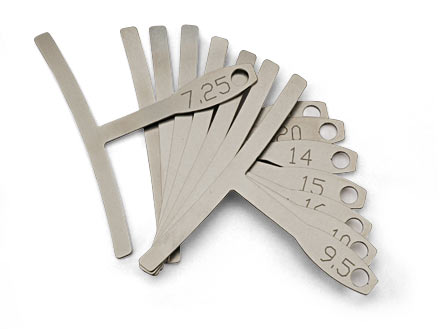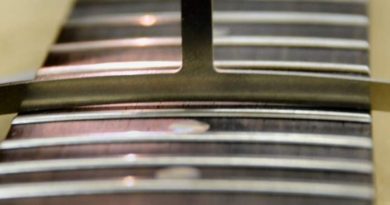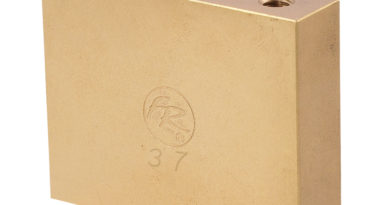Guitar Fretboard Radius Gauges
You don’t have to be a guitar tech nerd to benefit from a set of radius gauges. Fret not (ha! a pun!), I’m not going to get all “tech mode” here. But rather just check out a few common benefits for having some radius gauges on hand. If you’re like a lot of players, these numbers probably don’t mean all that much. Just tell me if it feels right when you’re playing? Know what I mean?
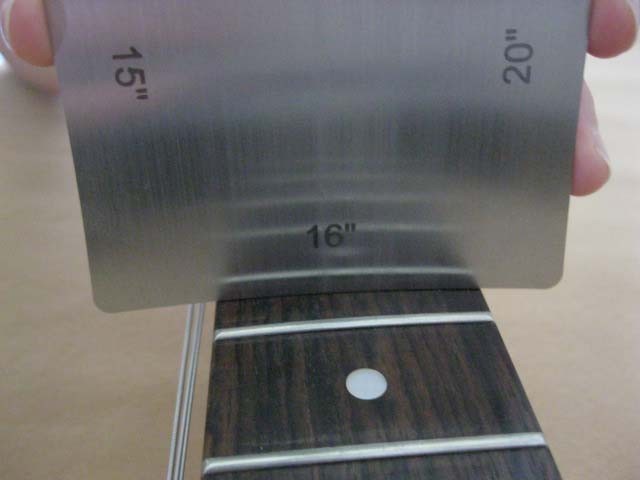
What Is “Radius”?
The very basic concept is that the numbers translate to that radius of a circle. The curvature of the fretboard is based on the size of a big circle, so to speak. A 16″ radius, like in the photo above, would be based on a circle with a 16″ radius. That’s considered to be a little on the flatter side for electric guitar. And you have the more “modern” Strat radius of 9.5″, which is like imagining a circle with a 9.5″ radius. That’s a smaller circle than the 16″ radius. So the surface of the 9.5″ radius will be more curved and not as flat as the 16″.
So, you ask, why do I care? Excellent question. The basis of your fingerboard radius will determine other factors. From there, it can be dialed in for good feel and good sound. I go in to more detail on Finger Board radius is THIS ARTICLE.
Once you determine the radius, one of the more common uses is to confirm saddle height. As shown in the photo of the understring radius gauge. Simply put, this helps nail a consistent string height across the fretboard. The understring style is good for that, as measuring from below will be more accurate.
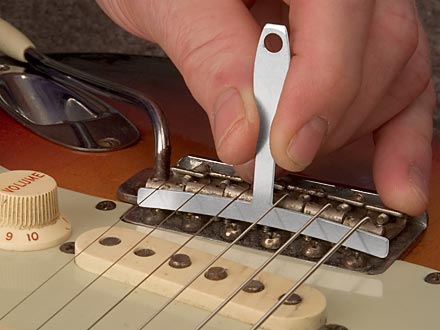
Going down to the other end of the fretboard, you can check your nut for accuracy in a similar fashion. The nut can also be a culprit in playability issues ranging from improper setup to normal wear and tear.
The More You Know
Knowing your neck radius and using a radius gauge can help dial in some basic starting points for pickup pole piece adjustments. Having a consistent string-to-pole distance can be a benefit. It’s a good starting point on a new pickup installation for a consistent response. And then dial in there for your personal preference.
Let’s say that you are more technically inclined to work on your guitar. If so, radius gauges are obviously one of the best ways to select the proper radius blocks when giving things a tune up. Ha! Another pun! You might discover you have a compound radius and you might prefer to use a range of radius blocks. Better yet, you might have ordered a compound radius and could use some radius gauges to confirm you get what you paid for.
One of the simplest and best reasons to use radius gauges is so that you know what you have and what works for you. Some players might be very adaptive from one guitar to another. Or you might be the Liam Neeson of guitars and have a very specific set of skills that requires a very specific set of needs. Knowing these sorts of specs can be efficient and help ensure the best results when dealing with your guitar tech or your guitar repair shop.
So pickup (lol! yet another pun!) some radius gauges for yourself. There are different styles to choose from to best suit your preferences. They are relatively easy to store and affordable.
7 string 16Ω 59 Airbucker Alnico 2 Alnico 4 Alnico 5 Alnico 8 Bare Knuckle BKP Boot Camp Brown Sound Celestion Ceramic Custom Shop David Shepherd DiMarzio Dual Resonance EVH Fishman Floyd Rose Fluence Gibson HSP90 Humbucker Ibanez JB Jimmy Page John Petrucci Les Paul MJ Mojotone P90 PAF Pariah Pickup Satch Seymour Duncan Singlecoil Single Width Speaker Steve Vai Tech Tip Tremolo Virtual Vintage

